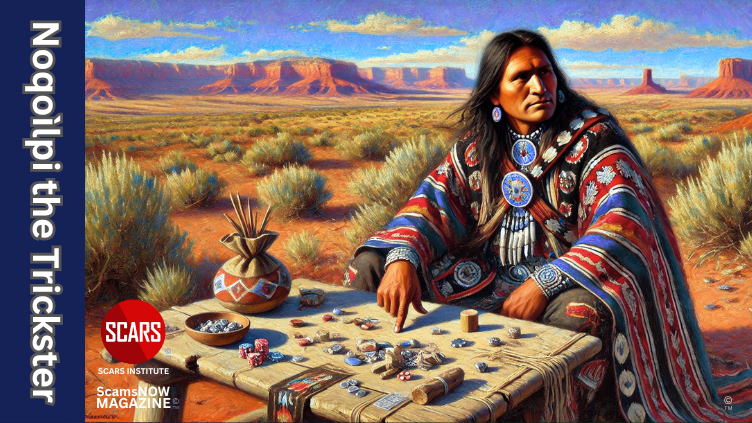
Noqoìlpi, the Navajo (Diné) Trickster
A Mythological Mirror to Modern Online Scammers and Their Victims
Primary Category: Mythology of Scams
Author:
• Tim McGuinness, Ph.D., DFin, MCPO, MAnth – Anthropologist, Scientist, Polymath, Director of the Society of Citizens Against Relationship Scams Inc.
Author Biographies Below
About This Article
The article uses the Navajo tale of Noqoìlpi, the Trickster Gambler, as a lens to understand modern online scams and their toll on individuals and communities. It traces how a charismatic outsider lures people with promises of easy gains, rigs the game through hidden tricks, escalates wagers until freedom is lost, and fractures social harmony. This pattern mirrors today’s phishing, romance, and crypto frauds that exploit hope, fear, and isolation. The narrative highlights victims’ intelligence and humanity, explaining how cognitive biases and manipulated trust drive escalation, while shame and silence deepen harm. It also shows the communal path back to balance through naming tactics, reporting crimes, strengthening boundaries, practicing nervous-system care, and rebuilding trust in circles of support. By pairing mythic warning with practical guidance, the piece argues that deception is ancient, recovery is communal, and vigilance, education, and shared voice restore hózhó, right relation, and dignity, online and off.
Note: This article is intended for informational purposes and does not replace professional medical advice. If you are experiencing distress, please consult a qualified mental health professional.

Noqoìlpi, the Navajo (Diné) Trickster: A Mythological Mirror to Modern Online Scammers and Their Victims
Myths and Legends as Mirrors to Our Modern World
In the vast tapestry of human history, myths and legends stand as timeless beacons, illuminating the depths of our collective consciousness and offering profound insights into the human condition. These ancient narratives, sometimes based on fact and sometimes born from the imaginations of our forebearers, are not mere fables but complex tapestries that weave together universal truths, psychological archetypes, and moral lessons. They serve as mirrors, reflecting the eternal struggles, triumphs, and transformations that define the human experience, and in doing so, they provide us with a unique lens through which to examine our present situations with greater clarity and depth of understanding.
Myths and legends are the stories that have survived the test of time, passed down through generations, each retelling adding layers of meaning and relevance. They speak to the archetypal aspects of our psyche, tapping into the shared experiences and emotions that bind us together as a species. Whether it’s the hero’s journey, the trickster archetype, or the battle between good and evil, these recurring themes resonate with us on a visceral level, offering a framework for understanding the complexities of our own lives and the world around us.
In the context of modern challenges, such as the rise of online scams and the devastating impact they have on individuals and communities, myths and legends offer a unique perspective. They allow us to step back from the immediacy of our experiences and view them through the lens of timeless narratives, revealing patterns and truths that might otherwise remain hidden. By drawing parallels between the characters and events of ancient myths and the realities of our digital age, we can gain a deeper understanding of the psychological and social dynamics at play, as well as the enduring human vulnerabilities that make us susceptible to deception and manipulation. We can see that these are not just modern phenomena, but have been with us all along, as long as there have been humans, there have been tricksters. That we are not the first to experience these abuses, which helps us to understand that we are not alone.
Myths and legends often embody universal warnings and lessons that remain as relevant today as they were in the past. They caution us against the dangers of unchecked ambition, the allure of easy gains, and the importance of harmony and balance in our lives. By examining these narratives, we can extract valuable insights that guide us in navigating the complexities of the modern world, helping us to make wiser choices and build more resilient communities.
As we explore the story of Noqoìlpi, the Trickster Gambler, from Navajo mythology, we find a striking analogy for the modern scammer and their victims. This ancient tale, with its themes of deception, greed, and the devastating consequences of unchecked ambition, mirrors the experiences of those who fall prey to online scams, either romantic or investment. By exploring this myth in detail, we can gain a deeper understanding of the psychological and social dynamics that underpin these modern-day deceptions, as well as the broader lessons that offer hope for healing and prevention.
In essence, myths and legends serve as powerful tools for self-reflection and societal introspection, allowing us to see our present situations with greater clarity and depth. They remind us that the challenges we face today are not new, but part of a continuous human story, and that by understanding the past, we can better navigate the present and shape a more enlightened future.
Noqoìlpi, the Trickster-Gambler
In the vast tapestry of Navajo (Diné) mythology, few figures are as captivating and cautionary as Noqoìlpi, the Trickster Gambler.
This supernatural being, a son of the Sun God Jóhonaa’éí and a mortal woman, embodies a timeless narrative of deception, greed, and the devastating consequences of unchecked ambition. As we delve into the story of Noqoìlpi, we find striking parallels with the modern phenomenon of online scams and the experiences of their victims, revealing a universal human vulnerability to the allure of easy gains and the manipulation of trust.
The Arrival of Noqoìlpi: A Charismatic Outsider
Noqoìlpi arrives among the Navajo people as a charismatic outsider, his very presence a promise of excitement and opportunity. He introduces gambling games, not as a mere pastime, but as a seductive trap, luring his victims with the prospect of easy wins and the thrill of risk. In the digital age, this charismatic outsider is embodied by the online scammer, who often presents themselves as a trustworthy entity, a potential partner in a lucrative venture, or a benevolent figure offering help or support. Just as Noqoìlpi’s charm and confidence are his greatest weapons, so too are the scammer’s ability to project authenticity and empathy, making them seem like a friend or ally rather than a threat.
The Art of Deception: Clever Tricks and Loaded Dice
Noqoìlpi’s games are not fair contests but carefully orchestrated deceptions, designed to ensure his victory. He employs clever tricks, loaded dice, and sleight-of-hand, manipulating the odds to his advantage. In the realm of online scams, these deceptive practices are mirrored in the use of sophisticated phishing techniques, fake websites, and manipulated data. Scammers exploit the trust and naivety of their victims, using emotional manipulation and psychological tactics to cloud judgment and override rational thought. Just as Noqoìlpi’s victims are unaware of the rigged nature of the games, online scam victims often remain oblivious to the deceptive strategies employed against them, drawn in by the promise of reward and the fear of missing out.
The Escalating Spiral: From Possessions to Freedom
As the games progress, Noqoìlpi’s victims wager increasingly valuable items, from their possessions and livestock to their spouses, children, and eventually their own freedom. This escalating spiral of bets and losses mirrors the compulsive behavior often seen in online scam victims, who may start with small investments or donations but quickly find themselves trapped in a cycle of escalating commitments. The scammer, like Noqoìlpi, encourages this behavior, preying on the victim’s desire to recover their losses and the false hope that the next bet or investment will be the one that turns their fortune around. This compulsive spiral can lead to the loss of not just financial resources but also personal dignity, relationships, and a sense of self-worth.
The Impact on Communities: Impoverishment and Subjugation
Noqoìlpi’s influence extends beyond individual victims, affecting entire communities and surrounding pueblos. People flock to play, drawn by the allure of easy wealth, and in doing so, they impoverish their communities and subjugate themselves to his power. In the digital world, the impact of online scams can be equally far-reaching, affecting not just individuals but entire families, communities, and even nations. The loss of financial resources, the erosion of trust, and the psychological trauma experienced by victims can have ripple effects, destabilizing social structures and undermining economic stability. Just as Noqoìlpi’s city is built on the backs of his enslaved laborers, the wealth and power amassed by scammers often come at the expense of the vulnerable and the trusting.
Divine Intervention: Exposing the Cheats and Banishing the Deceiver
The story of Noqoìlpi reaches its climax with divine intervention, often involving the trickster Coyote or other Holy People, who expose his cheats and banish him to the sky. This intervention serves as a reminder that justice, while delayed, is inevitable and that the deceptions of the powerful can be uncovered. In the context of online scams, this divine intervention can be seen as the collective efforts of law enforcement, cybersecurity experts, and vigilant communities working to expose scammers and bring them to justice. The banishment of Noqoìlpi to the sky symbolizes the ultimate defeat of deception and the restoration of balance, offering hope to those who have been victimized and a warning to those who might seek to exploit others.
The Scammer (Noqoìlpi): Preying on Human Vulnerabilities
Like online fraudsters, Noqoìlpi preys on human vulnerabilities, greed, hope for quick riches, desperation, or trust. His “games” are rigged from the start, mirroring how scammers use fake websites, bots, deepfakes, or scripted emotional manipulation to guarantee their gain while victims lose irreversibly. The escalation, starting small and then betting more, echoes how scams hook people with initial “wins” or refunds before draining accounts. Scammers, much like Noqoìlpi, are masters of deception, using a toolkit of sophisticated techniques to exploit their victims’ psychological and emotional weaknesses.
The Victims: Lured by Promises of Reward
The Navajo and neighboring peoples in the myth represent everyday people lured by promises of reward. They arrive voluntarily, often bringing valuables, and ignore warnings, much like scam victims who overlook red flags (e.g., “too good to be true” offers) due to FOMO (fear of missing out), loneliness, or financial stress. The story highlights how scams devastate communities, families broken, freedom lost, similar to real-world impacts where victims face bankruptcy, shame, or even suicide. Psychological research on scams shows that victims are often intelligent but exploited through cognitive biases like overconfidence or reciprocity. The allure of potential gain and the fear of missing out can cloud judgment, leading individuals to disregard obvious warning signs and rational thought.
Broader Lessons: Harmony Disrupted by Deception
The myth of Noqoìlpi warns against unchecked greed and deception, emphasizing the concept of harmony (hózhó) disrupted by outsiders’ tricks. Divine rescue parallels modern interventions like cybersecurity awareness, FTC reports, or law enforcement. Just as the Holy People intervene to expose Noqoìlpi’s cheats, contemporary society relies on collective efforts to combat online scams. Organizations and individuals work together to raise awareness, share information, and support victims, aiming to restore balance and justice in the face of digital deception.
In conclusion, the myth of Noqoìlpi, the Gambler, serves as a powerful allegory for the modern-day scammer and their victims. It reminds us of the timeless human vulnerabilities that make us susceptible to deception and the importance of vigilance, self-awareness, and community support in protecting ourselves and others from exploitation. By understanding the lessons embedded in this ancient story, we can better navigate the complexities of the digital world and work towards a future where harmony and trust prevail over greed and deceit.
Why Does Noqoìlpi Matter to Scam Victims?
Noqoìlpi, the Trickster Gambler (also spelled Náhwiłbihii or similar variations), from Navajo (Diné) mythology, serves as a striking analogy for modern online scammers and their victims.
In this traditional story, Noqoìlpi is a supernatural being, a son of the Sun God Jóhonaa’éí and a mortal woman, who arrives among the Navajo people as a charismatic outsider. He introduces gambling games, using clever tricks, loaded dice, and sleight-of-hand to ensure he always wins. Victims, drawn in by the allure of easy wins and escalating bets, wager their possessions, livestock, spouses, children, and eventually their own freedom, becoming enslaved to him. Entire communities are impoverished and subjugated as people from surrounding pueblos flock to play, losing everything in a compulsive spiral. Noqoìlpi amasses immense wealth and power, building a grand city with his enslaved laborers, until divine intervention (often involving the trickster Coyote or other Holy People) exposes his cheats and banishes him to the sky.
Why This Fits Scammers and Victims
The Scammer (Noqoìlpi): Like online fraudsters (e.g., phishing schemes, romance scams, crypto investment frauds, or fake lotteries), he preys on human vulnerabilities, greed, hope for quick riches, desperation, or trust. His “games” are rigged from the start, mirroring how scammers use fake stories, personas & identities, documents, websites, bots, deepfakes, or scripted emotional manipulation to guarantee their gain while victims lose irreversibly. The escalation (starting small, then betting more) echoes how scams hook people with initial “wins” or refunds before draining accounts in the case of investment scams, and romance and love in the case of romance scams.
The Victims: Navajo and neighboring peoples represent everyday people lured by promises of reward. They arrive voluntarily, often bringing valuables, and ignore warnings, much like scam victims who overlook red flags (e.g., “too good to be true” offers) due to FOMO (fear of missing out), exploited vulnerabilities, their own biases, or financial stress. The story highlights how scams devastate communities, families broken, freedom lost, similar to real-world impacts where victims face bankruptcy, shame, or suicide. Psychological research on scams shows victims are often intelligent but exploited through cognitive biases like overconfidence, sunk cost, and reciprocity. Learn more about cognitive biases here.
Broader Lessons: The myth warns against unchecked desires, greed, and deception, emphasizing harmony (hózhó) disrupted by outsiders’ tricks. Divine rescue parallels modern interventions like scam awareness, support & professional intervention, cybersecurity training, crime reports, or law enforcement busting scam rings. It underscores that scammers thrive on isolation and silence; victims in the story are too ashamed to tell and unable to stop, advising community vigilance.
This tale, part of the broader Diné Bahaneʼ (Navajo creation narrative), is retold in sources like Washington Matthews’ 19th-century collections and modern adaptations. While Coyote (Ma’ii) is the classic Navajo trickster for general folly, Noqoìlpi’s predatory tricks and gambling directly mirror exploitative scams.
Conclusion
The story of Noqoìlpi endures because it speaks to a pattern older than any device or platform. A charming outsider arrives with the promise of quick reward, bends the rules in secret, and feeds on silence and shame while communities fracture. This pattern now travels by text, app, and screen, but its engine is the same: manipulation of hope, fear, and loneliness; exploiting vulnerabilities of the victim. Seeing today’s scams through this older mirror restores perspective. It tells you that what happened to you was not a private failure. It was a rehearsed play with ancient lines.
Understanding the pattern is not the end of the story. It is the beginning of repair and healing. When you name the tricks, you reclaim judgment. When you speak up, you loosen the grip of isolation and control. When you share warnings, you help rebuild hózhó, balance, and right relation, at home and online. That is how communities once exposed Noqoìlpi’s loaded dice, and it is how neighborhoods, platforms, and authorities expose fraud now.
Practical steps flow from this clarity. You document, report, and lean on trusted allies. You seek care for the nervous system jolts and deep trauma that follows betrayal. You join support groups where survivors trade knowledge and mutual support, not blame. You replace secrecy with speaking, steady routines, and you make small, verifiable choices that rebuild confidence. Each action lifts you out of the rigged game and back into a life shaped by consent, boundaries, and truth.
Myths survive because they carry instructions for hard times. This one offers three: be wary of the promise that bypasses effort, stand together when deception spreads, and call things by their right names. If you carry those forward, the trickster loses ground. What remains is the work of repair, patient, communal, and dignified, and the knowledge that your voice and your story strengthen the next person who needs a way out.

Glossary
- Acceptance of Mythic Lessons — This concept describes how timeless stories offer practical guidance for modern harms. It frames ancient narratives as tools that help scam victims name patterns, reduce shame, and choose safer actions.
- Allure of Easy Gains — This refers to the tempting promise of quick profit or effortless reward. It lowers judgment, increases risk-taking, and keeps targets engaged long after losses begin.
- Banishment (Mythic Consequence) — This is the removal of a deceiver from the community after exposure. It symbolizes accountability in modern contexts through legal action, platform bans, or social consequences.
- Boundary-Setting — This is the practice of defining what contact, requests, or disclosures are acceptable. It protects attention, money, and dignity by limiting access that scammers try to exploit.
- Charismatic Outsider — This describes a newcomer who arrives with confidence and persuasive charm. The role softens defenses, accelerates trust, and opens a path for manipulation.
- Cognitive Biases — These are predictable shortcuts in judgment that can be exploited by deception. They include overconfidence, sunk-cost persistence, and familiarity effects that keep victims engaged.
- Community Vigilance — This is a shared commitment to warn, verify, and act together. It reduces isolation, surfaces patterns quickly, and interrupts ongoing harm.
- Coyote (Trickster Ally) — In Diné stories, Coyote exposes cheats and restores balance. The figure represents modern allies such as investigators, journalists, and advocates who reveal fraud methods.
- Deepfake Deception — This is the use of synthetic audio, video, or images to impersonate people. It increases credibility for false stories and pressures quick decisions.
- Divine Intervention (Mythic Exposure) — This refers to a decisive revelation that ends a deceiver’s dominance. It parallels coordinated reporting, forensic audits, and cross-agency work that stop scams.
- Escalation Spiral — This is the steady increase from small wagers or transfers to life-altering losses. It is powered by urgency, staged “wins,” and the drive to recover sunk costs.
- Fraud Ecosystem — This describes the networks, tools, and roles that enable large-scale deception. It includes identity brokers, social bots, money mules, and laundering channels.
- Gaslighting — This is a tactic that makes a target doubt memory, perception, or judgment. It replaces reality with the deceiver’s script and delays help-seeking.
- Grooming — This is the stepwise process of gaining trust, testing boundaries, and shaping compliance. It blends attention, flattery, and staged vulnerability to secure control.
- Hózhó (Balance and Right Relation) — In Diné thought, hózhó is harmony, beauty, and balance. The term frames recovery goals: truth, community repair, and dignified boundaries.
- Loaded Dice — This symbolizes hidden advantages baked into a game or offer. It maps to rigged platforms, fake dashboards, and staged testimonials that guarantee the scammer wins.
- Mythic Mirror — This is the use of legend to reflect current harms and choices. It helps readers see recurring patterns and reduce self-blame by placing events in context.
- Navajo (Diné) Tradition — This references the cultural source of the Noqoìlpi narrative. It anchors lessons in a living people’s teachings on balance, caution, and community repair.
- Noqoìlpi (Trickster Gambler) — This figure personifies deception that feeds on greed, loneliness, and silence. The story models how manipulation grows and how exposure restores balance.
- Online Impersonation — This is the creation of false identities, roles, or affiliations to gain trust. It often includes stolen photos, fabricated credentials, and scripted life stories.
- Phishing Pretext — This is the crafted scenario that prompts a click, login, or payment. It leans on urgency, authority, or sympathy to bypass careful checking.
- Red Flags — These are observable cues that suggest elevated risk. Examples include secrecy demands, pressure to move off-platform, payment through crypto or gift cards, and refusal of verification.
- Reporting Pathways — These are formal routes to notify platforms, banks, and authorities. Timely reports can freeze funds, document crimes, and prevent further victimization.
- Rigged Game — This describes any arrangement where outcomes are fixed against the target. It looks like fake trading results, controlled lotteries, or guarantees that defy scrutiny.
- Scammer Playbook — This is the repeatable sequence of tactics used to extract money or data. It typically includes grooming, isolation, staged urgency, and escalating asks.
- Shame and Silence — This pair of reactions keeps harm hidden and prolongs control. Breaking the silence restores perspective, enables support, and helps others avoid similar traps.
- Sleight of Hand — This is a distraction used to hide the real move. Online, it appears as complex dashboards, noisy chat, or ceremonial steps that conceal the transfer.
- Social Engineering — This is the use of psychology instead of force to obtain access or money. It thrives on trust, routine, and helpfulness within families and organizations.
- Spiral of Losses — This is the compounding effect of repeated payments, loans, or sales of assets. It drains savings, strains relationships, and deepens dependence on the deceiver.
- Support Networks — These are trustworthy circles that provide validation, guidance, and practical help. They include survivors, advocates, clinicians, and financial counselors.
- Trust Manipulation — This is the deliberate shaping of belief through consistency, empathy, and staged proof. It converts doubt into commitment and keeps targets engaged.
- Victim Safeguards — These are protective steps that reduce exposure and speed recovery. Examples include verification rituals, separate devices for banking, and pre-written refusal scripts.
- Victim-Blaming Trap — This is the tendency to assign fault to the harmed person rather than the offender. It blocks reporting, delays care, and ignores the intentional design of scams.
- Vigilant Skepticism — This is a calm habit of checking claims, sources, and incentives. It slows decisions, invites second opinions, and filters offers that bypass effort.
- Whistleblowing — This is the act of publicly or formally exposing wrongdoing. It protects future targets, informs authorities, and can trigger restitution or sanctions.
- Witnessing and Telling — This is the practice of narrating events plainly to trusted listeners. It counters isolation, organizes memory, and turns experience into prevention.
Reference
The Story of NOQOILPI
THE JOURNAL OF AMERICAN FOLK-LORE. Vol. II., APRIL-JUNE, 1889. No. V.
NOQOILPI, 1 THE GAMBLER: A NAVAJO MYTH.
In the canon of the Chaco, in northern New Mexico, there are many ruins of ancient pueblos which are still in a fair state of preservation, in some of them entire apartments being yet, it is said, intact.
One of the largest of these is called by the Navajos Kintyel or Kintyeli, which signifies ” Broad-house.” It figures frequently in their legends and is the scene of a very interesting rite-myth, which I have in my collection. I have reason to believe that this pueblo is identical with that seen and described in 1849 by Lieut. J. H. Simpson, U.S.A., 2 under the name of Pueblo Chettro Kettle. Although his guide translated this ” Rain Pueblo,” it seems more probably a corruption of the Navajo Tsegqa or Tcegqa (Englished Chethra) Kintyel, or Broad House among the Cliffs, i.e. in the canon. This story of Noqollpi was not related to me as a separate tale, but as a part of the great creation and migration legend of the Navajos.
When the wandering Navajos arrived at Kintyeli, this great pueblo was in process of building, but was not finished. The way it came to be built was this:
Some time before, there had descended among the Pueblos, from the heavens, a divine gambler or gambling-god, named Noqoilpi, or He-who-wins-men (at play); his talisman was a great piece of turquoise. When he came, he challenged the people to all sorts of games and contests, and in all of these, he was successful. He won from them, first their property, then their women and children, and finally some of the men themselves. Then he told them he would give them part of their property back in payment if they would build a great house; so when the Navajos came, the Pueblos were busy building, in order that they might release their enthralled relatives and their property. They were also busy making a race-track and preparing for all kinds of games of chance and skill.
When all was ready, and four days’ notice had been given, twelve men came from the neighboring pueblo of Kincolij (Blue-house) to compete with the great gambler. They bet their own persons, and after a brief contest, they lost themselves to Noqoilpi. Again, a notice of four days was given, and again twelve men of Kinijolfj — relatives of the former twelve — came to play, and these also lost themselves.
For the third time, an announcement, four days in advance of a game, was given; this time, some women were among the twelve contestants, and they too lost themselves. All were put to work on the building of Kintyeli as soon as they forfeited their liberty. At the end of another four days, the children of these men and women came to try to win back their parents, but they succeeded only in adding themselves to the number of the gambler’s slaves. On a fifth trial, after four days’ warning, twelve leading men of Blue-house were lost, among them the chief of the pueblo. On a sixth duly announced gambling-day twelve more men, all important persons, staked their liberty and lost it. Up to this time, the Navajos had kept count of the winnings of Noqoilpi, but afterwards, people from other pueblos came in such numbers to play and lose that they could keep count no longer. In addition to their own persons, the later victims brought in beads, shells, turquoise, and all sorts of valuables, and gambled them away. With the labor of all these slaves, it was not long until the great Kintyeli was finished.
But all this time, the Navajos had been merely spectators and had taken no part in the games. One day the voice of the beneficent god Qastceyalci was heard faintly in the distance, crying his usual call “hu’ hu’ hu’ hu’.” His voice was heard, as it is always heard, four times, each time nearer and nearer, and immediately after the last call, which was loud and clear, Qastceyalcj appeared at the door of a hut where dwelt a young couple who had no children, and with them he communicated by means of signs. He told them that the people of Kincolij had lost at a game with Noqoilpi two great shells, the greatest treasures of the pueblo; that the Sun had coveted these shells, and had begged them from the gambler; that the latter had refused the request of the Sun and the Sun was angry. In consequence of all this, as Qastceyalcji related, in twelve days from his visit, certain divine personages would meet in the mountains, in a place which he designated, to hold a great ceremony. He invited the young man to be present at the ceremony and disappeared.
The Navajo kept count of the passing days; on the twelfth day he repaired to the appointed place, and there he found a great assemblage of the gods. There were Qastceyalcj, Qastceqogan and his son, Nfltci, the Wind, Tcalyel, the Darkness, Tcaapani, the Bat, Klictsd, the Great Snake, Tsilkali (a little bird), Nasfsi, the Gopher, and many others. Beside these, there were present a number of pets or domesticated animals belonging to the gambler, who were dissatisfied with their lot, were anxious to be free, and would gladly obtain their share of the spoils in case their master was ruined. Nfltci, the Wind, had spoken to them, and they had come to enter into the plot against Noqoilpi. All night the gods danced and sang, and performed their mystic rites, for the purpose of giving to the son of Qastceqogan powers as a gambler equal to those of Noqoilpi. When the morning came, they washed the young neophyte all over, dried him with meal, dressed him in clothes exactly like those the gambler wore, and in every way made him look as much like the gambler as possible, and then they counseled as to what other means they should take to outwit Noqoilpi.
In the first place, they desired to find out how he felt about having refused to his father, the Sun, the two great shells. ” I will do this,” said Nfltci, the Wind, ” for I can penetrate everywhere, and no one can see me; “but the others said, ” No, you can go everywhere, but you cannot travel without making a noise and disturbing people. Let Tcalyel, the Darkness, go on this errand, for he also goes wherever he wills, yet he makes no noise.” So Tcalyel went to the gambler’s house, entered his room, went all through his body while he slept, and searched well his mind, and he came back saying, ” Noqoilpi is sorry for what he has done.” Nfltci, however, did not believe this; so, although his services had been before refused, he repaired to the chamber where the gambler slept, and went all through his body and searched well his mind; but he too came back saying Noqoilpi was sorry that he had refused to give the great shells to his father.
One of the games they proposed to play is called caka-gqadsaga, or the thirteen chips; it is played with thirteen thin flat pieces of wood, which are colored red on one side and left white or uncolored on the other side. Success depends on the number of chips, which, being thrown upward, fall with their white sides up. ” Leave the game to me,” said the Bat; ” I have made thirteen chips that are white on both sides. I will hide myself in the ceiling, and when our champion throws up his chips I will grasp them and throw down my chips instead.”
Another game they were to play is called na n joj; it is played with two long sticks or poles, of peculiar shape and construction (one marked with red and the other with black), and a single hoop. A long many-tailed string, called the ” turkey-claw,” is secured to the centre of each pole. ” Leave na n joj to me,” said the Great Snake; ” I will hide myself in the hoop and make it fall where I please.”
Another game was one called tsi’nbetsil, or push-on-the-wood; in this the contestants push against a tree until it is torn from its roots and falls. ” I will see that this game is won,” said Nasisi, the Gopher; ” I will gnaw the roots of the tree, so that he who shoves it may easily make it fall.”
In the game of tcol, or ball, the object was to hit the ball so that it would fall beyond a certain line. ” I will win this game for you,” said the little bird, Tsilkali, ” for I will hide within the ball, and fly with it wherever I want to go. Do not hit the ball hard; give it only a light tap, and depend on me to carry it.”
The pets of the gambler begged the Wind to blow hard, so that they might have an excuse to give their master for not keeping due watch when he was in danger, and in the morning the Wind blew for them a strong gale. At dawn, the whole party of conspirators left the mountain and came down to the brow of the canon to watch until sunrise.
Noqoilpi had two wives, who were the prettiest women in the whole land. Wherever she went, each carried in her hand a stick with something tied on the end of it, as a sign that she was the wife of the great gambler.
It was their custom for one of them to go every morning at sunrise to a neighboring spring to get water. So at sunrise, the watchers on the brow of the cliff saw one of the wives coming out of the gambler’s house with a water-jar on her head, whereupon the son of Qastceqogan descended into the canon, and followed her to the spring. She was not aware of his presence until she had filled her water-jar; then she supposed it to be her own husband, whom the youth was dressed and adorned to represent, and she allowed him to approach her.
She soon discovered her error, however, but deeming it prudent to say nothing, she suffered him to follow her into the house. As he entered, he observed that many of the slaves had already assembled; perhaps they were aware that some trouble was in store for their master. The latter looked up with an angry face; he felt jealous when he saw the stranger entering immediately after his wife. He said nothing of this, however, but asked at once the important question, ” Have you come to gamble with me ? “ This he repeated four times, and each time the young Qastceqogan said ” No.” Thinking the stranger feared to play with him, Noqoilpi went on challenging him recklessly. “I’ll bet myself against yourself;” “I’ll bet my feet against your feet; ” “I ’11 bet my legs against your legs; “ and so on he offered to bet every and any part of his body against the same part of his adversary, ending by mentioning his hair.
In the meantime, the party of divine ones, who had been watching from above, came down, and people from the neighboring pueblos came in, and among these were two boys, who were dressed in costumes similar to those worn by the wives of the gambler. The young Qastceqogan pointed to these and said, ” I will bet my wives against your wives.” The great gambler accepted the wager, and the four persons, two women and two mock women, were placed sitting in a row near the wall. First, they played the game of thirteen chips.
The Bat assisted, as he had promised the son of Qastceqogan, and the latter soon won the game, and with it the wives of Noqoilpi.
This was the only game played inside the house; then all went out of doors, and games of various kinds were played. First, they tried na n joj. The track already prepared lay east and west, but, prompted by the wind god, the stranger insisted on having a track made from north to south, and again, at the bidding of the Wind, he chose the red stick. The son of Qastceqogan threw the wheel: at first it seemed about to fall on the gambler’s pole, in the ” turkey-claw “ of which it was entangled; but to the great surprise of the gambler, it extricated itself, rolled farther on, and fell on the pole of his opponent. The latter ran to pick up the ring, lest Noqoilpi in doing so might hurt the Snake inside; but the gambler was so angry that he threw his stick away and gave up the game, hoping to do better in the next contest, which was that of pushing down trees.
For this, the great gambler pointed out two small trees, but his opponent insisted that larger trees must be found. After some search, they agreed upon two of good size, which grew close together, and of these the wind-god told the youth which one he must select. The gambler strained with all his might at his tree, but could not move it, while his opponent, when his turn came, shoved the other tree prostrate with little effort, for its roots had all been severed by the Gopher.
Then followed a variety of games, on which Noqoilpi staked his wealth in shells and precious stones, his houses, and many of his slaves, and lost all.
The last game was that of the ball. On the line over which the ball was to be knocked, all the people were assembled: on one side were those who still remained slaves; on the other side were the freedmen and those who had come to wager themselves, hoping to rescue their kinsmen. Noqoilpi bet on this game the last of his slaves and his own person. The gambler struck his ball a heavy blow, but it did not reach the line; the stranger gave his but a light tap, and the bird within it flew with it far beyond the line, whereat the released captives jumped over the line and joined their people.
The victor ordered all the shell beads and precious stones, and the great shells to be brought forth. He gave the beads and shells to Qastceyalsi, that they might be distributed among the gods; the two great shells were given to the Sun. 1
In the meantime, Noqoilpi sat to one side, saying bitter things, bemoaning his fate, and cursing and threatening his enemies: ” I will kill you all with the lightning. I will send war and disease among you. May the cold freeze you ! May the fire burn you ! May the waters drown you ! “ he cried. ” He has cursed enough,” whispered Niltci to the son of Qastceqogan. ” Put an end to his angry words.”
So the young victor called Noqoilpi to him, and said, ” You have bet yourself and have lost; you are now my slave and must do my bidding. You are not a god, for my power has prevailed against yours.” The victor had a bow of magic power named Esin (Zilyil, or the Bow of Darkness); he bent this upwards, and placing the string on the ground, he bade his illustrious slave stand on the string; then he shot Noqoilpi up into the sky as if he had been an arrow. Up and up he went, growing smaller and smaller to the sight till he faded to a mere speck, and finally disappeared altogether. As he flew upwards he was heard to mutter in the angry tones of abuse and imprecation, until he was too far away to be heard; but no one could distinguish anything he said as he ascended.
He flew up in the sky until he came to the home of Bekotcijze, the god who carries the moon, and who is supposed by the Navajos to be identical with the god of the Americans. He is very old and dwells in a long row of stone houses. When Noqoilpi arrived at the house of Bekotcijze, he related to the latter all his misadventures in the lower world and said, ” Now I am poor, and this is why I have come to see you.” ” You need be poor no longer,” said Bekotcijze; ” I will provide for you.” So he made for the gambler pets or domestic animals of new kinds, different to those which he had in the Chaco valley; he made for him sheep, asses, horses, swine, goats, and fowls. He also gave him bayeta, and other cloths of bright colors, more beautiful than those woven by his slaves at Kintyeli. He made, too, a new people, the Mexicans, for the gambler to rule over, and then he sent him back to this world again, but he descended far to the south of his former abode, and reached the earth in old Mexico.
Noqoilpi’s people increased greatly in Mexico, and after a while, they began to move toward the north and build towns along the Rio Grande. Noqoilpi came with them until they arrived at a place north of Santa Fe. There they ceased building, and he returned to old Mexico, where he still lives, and where he is now the Nakai Oigini, or God of the Mexicans.
By Washington Matthews.
Footnotes:
- 1 In spelling the Navajo words, the alphabet of the Bureau of Ethnology is used; / is aspirated.
- 2 In Journal of a Military Reconnoissance from Santa Fi, New Mexico, to the Navajo Country, etc., Ex. Doc. No. 64, 31st Congress, 1st Session [Senate} ” Reports of the Secretary of War,” etc., Washington, 1850, p. 79.
Author Biographies
Please Rate This Article
Please Leave Us Your Comment Below
Also, tell us of any topics we might have missed.
-/ 30 /-
What do you think about this?
Please share your thoughts in a comment above!
ARTICLE RATING
TABLE OF CONTENTS
- A Mythological Mirror to Modern Online Scammers and Their Victims
- Noqoìlpi, the Navajo (Diné) Trickster: A Mythological Mirror to Modern Online Scammers and Their Victims
- Myths and Legends as Mirrors to Our Modern World
- Noqoìlpi, the Trickster-Gambler
- Why Does Noqoìlpi Matter to Scam Victims?
- Conclusion
- Glossary
- Reference
CATEGORIES
U.S. & Canada Suicide Lifeline 988
![NavyLogo@4x-81[1] Noqoìlpi, the Navajo (Diné) Trickster - Mythology of Scams - 2025](https://scamsnow.com/wp-content/uploads/2025/04/NavyLogo@4x-811.png)
ARTICLE META
Important Information for New Scam Victims
- Please visit www.ScamVictimsSupport.org – a SCARS Website for New Scam Victims & Sextortion Victims.
- SCARS Institute now offers its free, safe, and private Scam Survivor’s Support Community at www.SCARScommunity.org – this is not on a social media platform, it is our own safe & secure platform created by the SCARS Institute especially for scam victims & survivors.
- SCARS Institute now offers a free recovery learning program at www.SCARSeducation.org.
- Please visit www.ScamPsychology.org – to more fully understand the psychological concepts involved in scams and scam victim recovery.
If you are looking for local trauma counselors, please visit counseling.AgainstScams.org
If you need to speak with someone now, you can dial 988 or find phone numbers for crisis hotlines all around the world here: www.opencounseling.com/suicide-hotlines
Statement About Victim Blaming
Some of our articles discuss various aspects of victims. This is both about better understanding victims (the science of victimology) and their behaviors and psychology. This helps us to educate victims/survivors about why these crimes happened and not to blame themselves, better develop recovery programs, and help victims avoid scams in the future. At times, this may sound like blaming the victim, but it does not blame scam victims; we are simply explaining the hows and whys of the experience victims have.
These articles, about the Psychology of Scams or Victim Psychology – meaning that all humans have psychological or cognitive characteristics in common that can either be exploited or work against us – help us all to understand the unique challenges victims face before, during, and after scams, fraud, or cybercrimes. These sometimes talk about some of the vulnerabilities the scammers exploit. Victims rarely have control of them or are even aware of them, until something like a scam happens, and then they can learn how their mind works and how to overcome these mechanisms.
Articles like these help victims and others understand these processes and how to help prevent them from being exploited again or to help them recover more easily by understanding their post-scam behaviors. Learn more about the Psychology of Scams at www.ScamPsychology.org
SCARS INSTITUTE RESOURCES:
If You Have Been Victimized By A Scam Or Cybercrime
♦ If you are a victim of scams, go to www.ScamVictimsSupport.org for real knowledge and help
♦ SCARS Institute now offers its free, safe, and private Scam Survivor’s Support Community at www.SCARScommunity.org – this is not on a social media platform, it is our own safe & secure platform created by the SCARS Institute especially for scam victims & survivors.
♦ Enroll in SCARS Scam Survivor’s School now at www.SCARSeducation.org
♦ To report criminals, visit https://reporting.AgainstScams.org – we will NEVER give your data to money recovery companies like some do!
♦ Follow us and find our podcasts, webinars, and helpful videos on YouTube: https://www.youtube.com/@RomancescamsNowcom
♦ Learn about the Psychology of Scams at www.ScamPsychology.org
♦ Dig deeper into the reality of scams, fraud, and cybercrime at www.ScamsNOW.com and www.RomanceScamsNOW.com
♦ Scam Survivor’s Stories: www.ScamSurvivorStories.org
♦ For Scam Victim Advocates visit www.ScamVictimsAdvocates.org
♦ See more scammer photos on www.ScammerPhotos.com
You can also find the SCARS Institute’s knowledge and information on Facebook, Instagram, X, LinkedIn, and TruthSocial
Psychology Disclaimer:
All articles about psychology and the human brain on this website are for information & education only
The information provided in this and other SCARS articles are intended for educational and self-help purposes only and should not be construed as a substitute for professional therapy or counseling.
Note about Mindfulness: Mindfulness practices have the potential to create psychological distress for some individuals. Please consult a mental health professional or experienced meditation instructor for guidance should you encounter difficulties.
While any self-help techniques outlined herein may be beneficial for scam victims seeking to recover from their experience and move towards recovery, it is important to consult with a qualified mental health professional before initiating any course of action. Each individual’s experience and needs are unique, and what works for one person may not be suitable for another.
Additionally, any approach may not be appropriate for individuals with certain pre-existing mental health conditions or trauma histories. It is advisable to seek guidance from a licensed therapist or counselor who can provide personalized support, guidance, and treatment tailored to your specific needs.
If you are experiencing significant distress or emotional difficulties related to a scam or other traumatic event, please consult your doctor or mental health provider for appropriate care and support.
Also read our SCARS Institute Statement about Professional Care for Scam Victims – click here
If you are in crisis, feeling desperate, or in despair, please call 988 or your local crisis hotline.
More ScamsNOW.com Articles
A Question of Trust
At the SCARS Institute, we invite you to do your own research on the topics we speak about and publish. Our team investigates the subject being discussed, especially when it comes to understanding the scam victims-survivors’ experience. You can do Google searches, but in many cases, you will have to wade through scientific papers and studies. However, remember that biases and perspectives matter and influence the outcome. Regardless, we encourage you to explore these topics as thoroughly as you can for your own awareness.























![scars-institute[1] Noqoìlpi, the Navajo (Diné) Trickster - Mythology of Scams - 2025](https://scamsnow.com/wp-content/uploads/2025/04/scars-institute1.png)
![niprc1.png1_-150×1501-1[1] Noqoìlpi, the Navajo (Diné) Trickster - Mythology of Scams - 2025](https://scamsnow.com/wp-content/uploads/2025/04/niprc1.png1_-150x1501-11.webp)
